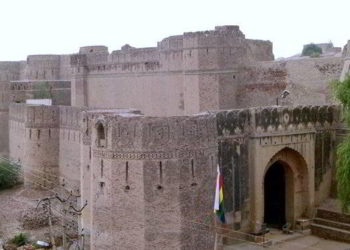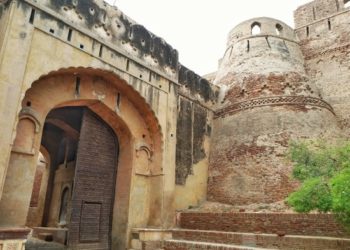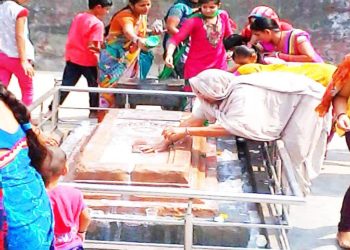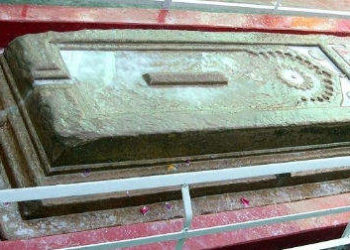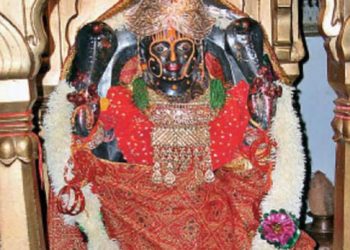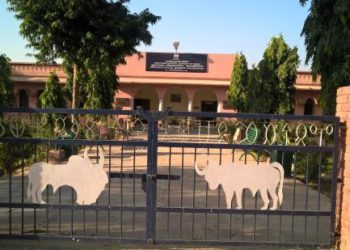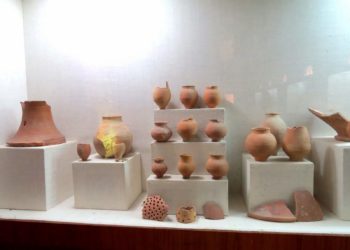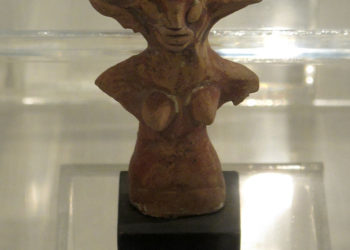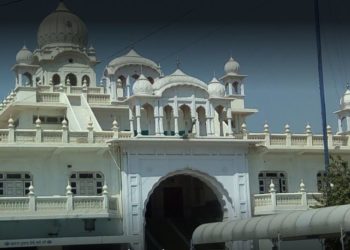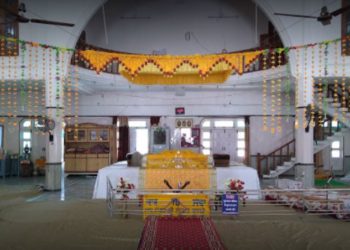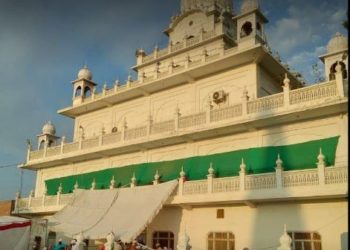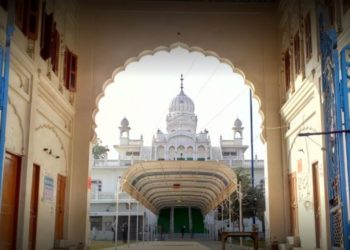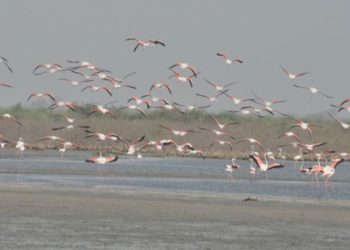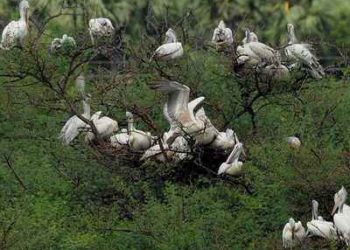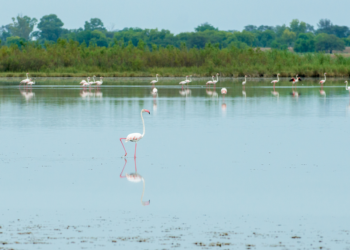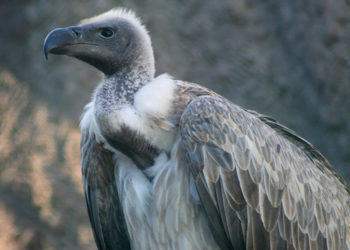Bhatner Fort
The Bhatner Fort, otherwise known as the Hanumangarh Fort, is located on the banks of the River Gaggar in the centre of Hanumangarh. It is five kilometres from Hanumangarh Junction Railway Station and 230 km north-east of Bikaner, in the extreme northern part of Rajasthan. Believed to be over 1700 years old, it is considered to be one of the oldest Indian forts. The earlier name of Hanumangarh was Bhatner that was once ruled by the Bhatti Rajputs. In 295 AD, Bhupat, son of Jailsamer’s King Bhatti built this strong fort. Since then, rulers like Timur, Ghaznavis, PrtihviRaj Chauhan, Akbar, Qutub-ud-din-Aybak and Rathores had captured this fort.... This fort has been mostly popular for its invincibility as after repeated attempts by various clans only few could gain control over this fort. Maharaj Jait Singh of Bikaner captured this fort in 1527, which was finally captured by Surat Singh in 1805, after going through many annexations between the Kingdom of Bikaner and the Mughals. There is also a tomb inside this fort, where Sher Khan is kept. Sher Khan was the nephew of Sultan Ghiyas-ud-din-Balban (1266 – 1290) as well as the Governor of the Fort.
Sheela Mata Temple
Seela-Mata Temple, a great example of communal Harmony. Situated in the ‘known to be as the area of old stream of vedic river Saraswati’, presently Hanumangarh Town. It is believed that milk and water offered to Sila Mata-Sila Peer cures all types of skin diseases, if applied. People from all the castes and creeds come to offer their pray here and weekly fair also takes place on every thursday. ... This 6′ x 2.5′ x 2′ size stone is worshiped by Hindus, Sikhs and Muslims. The Hindus-Sikhs call this Shila Mata and Muslims call it Shila Peer.
Bhadarkali Temple
The ancient historical temple of Mata Bhadrakali situated at bank of river Ghaggar near village Amarpura Thedi of Tehsil Hanumangarh, 7 kms from district headquarter. The sixth emperor of Bikaner Maharaja Ram Singh said to have constructed this temple on Badshah Akbar’s desire. Though pilgrims visit the temple through out the year but during the Mela days on Chaitr Sudi 8 and 9, thousands of pilgrims from Punjab, Haryana and Rajasthan visit the temple to worship MAA BHADRAKALI. Located at a distance of seven kilometres from the city of Hanumangarh, the temple of Mata Bhadrakaliji stands on the banks of River Ghaggar that is close to Amarpura Thedi Village. The presiding deity of this temple is Mata Bhadrakali, which is one of the many avatars of Goddess Durga. ...The temple belongs to the Shakti Sect of Hinduism. History states that the 6th ruler of Bikaner, Maharaja Ram Singh, constructed this temple to fulfill the desire of Akbar, the Mughal Emperor. Later on, Maharaja Dhri Ganga Singhji, the King of Bikaner, reconstructed this temple. The temple is constructed of bricks, mortar and lime. It has a loft round shaped dome along with a verandah, a kitchen, a Sanctum Sanctorum and a hall for prayers. The main idol of this temple is built with red stone that is 2.6 feet high and covered in ornaments. The temple is open every day. However, it gets crowded on the 8th and 9th day in the month of Chaitra due to the mela that is celebrated here during that time.
Kalibanga Museum
The location of Kalibanga is Pilibangā, between Suratgarh and Hanumāngarh in Hanumangarh district of Rajasthan. It was excavated by A Ghosh in 1953 and later by BB Lal & B K Thapar in 1961. It has given the evidence of both Pre harappan culture in the lower layer and harappan civilization in the upper layer. Kalibanga means black bangles. The most important discovery of Kalibanga is a ploughed field. A wooden furrow has been found, 7 fire altars in a row have been found and they suggest the practice of sacrifice.... Bones of camel have been found at Kalibanga. At Kalibanga a tiled floor which bears the intersecting signs of circles has been found. The burials have been found in two types of pits viz. circular graves and rectangular graves. The bricks used in Kalibanga were earthen ones and Kalibanga was not as better planned. There was no drainage system in Kalibanga. The Hanumangarh district also has a significant place in the ancient history. The remains found at Kalibangan[Pilibanga] in 1951 reveal that this area was a part of nearly 5000 years old Indus Valley Civilization. The remains of human skeleton, unknown scripts, stamps, coins, utensils, jewelry, toys, statues, wells, bathrooms, fort, streets, markets etc., found in excavation tell the story of well developed life style of our ancestors. Besides Kalibangan, more than 100 other places are also there in the district where evidences of this old civilization have been found. The remains found at these places have been kept at Museum at Kalibangan and National Museum, New Delhi.
Shaid Baba Sukha Singh Mehitab Singh Ji Gurudwara
The historically important Gurdwara of Shaheedan Da is located in the city of Hanumangarh. In the 18th century AD, when this gurdwara was constructed, it was named after two martyrs. According to history, when the Emperor of Afghanistan, Nadir Shah was moving back to Persia after looting and plundering numerous Indian cities in 1739, his forces were attacked by the Sikhs who rescued many young women and goods that were stolen by the forces....After his return to Persia, Nadir Shah made Zakhrya Khan to act as the Governor of Lahore who vowed to destroy the Sikhs, for which he declared a reward to anybody who could bring the head of a Sikh.Once a Massa Ranghar brought a cart full of heads of Sikhs to Zakhrya Khan, as a reward to which he was appointed the Chief of Amritsar. Taking charge of the Golden Temple of Amritsar, Massa Ranghar prohibited the Sikhs from entering this temple and started drinking and brought dancers at the pious temple. When this news reached the Bikaner’s Sikhs, they became enraged. Then two Sikhs, namely, Bhai Mehtab Singh and Bhai Sukha Singh went to Amritsar to teach Massa Ranghar a lesson. As they carried bags full of coins, the watchmen didn’t prevent them from entering the Golden Temple. They went to a drunken Massa Ranghar who was watching the dancing girls and placed the bags full of coins in front of him. As he bent to take a look at the bag, these two Sikhs severed his head, took it and vanished from there in no time. These two Sikhs came to Hanumangarh with Massa Ranghar’s head and rested under a tree. Later on they were captured and tortured to death by the Mughals who wanted them to convert to Islam. They refused this offer and attained martyrdom. Every year, in this gurdwara on Amavasya, thousands of devotees attend the Yadgari Jod Mela.
Badopal Bird Sanctuary
The village Badopal is situated at the north west of District Hanumangarh . This is precisely an ecotone area which on one side has flora and fauna of Thar desert & other side area full of water in vast stretches due to overflow of canal supply sytem prevalent in irrigated areas of district Hanumangarh. Local folks of nearby villagers cite Maharaja Ganga Singh of Bikaner once used this area as a part of the hunting / shooting pastime. ... The visit of Maharaja as per locals was mostly during rainy seasons and winter. The old structures of horse stables and very old temples is still present there. While Indira Gandhi canal was being constructed , the excess flow from the Bhakhra Dam was discharged by various escapes and siphons in Badopal area. These surplus volume of water gets stagnated in the area for a period of eight to nine months in these area. Presently whenever there is excess of water flow from Bhakra Dam , the excess water is being discharged in this area. Also whenever the water exceeds the required level in Ottu Head , the surplus volume of water is discharged from the escape routes of Ghaggar river system. The extent of the water logged area is about 84000 bigha.

